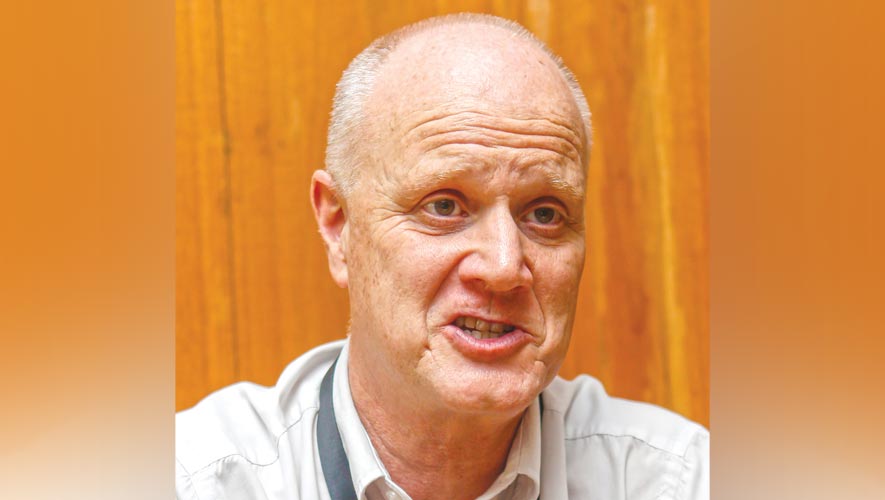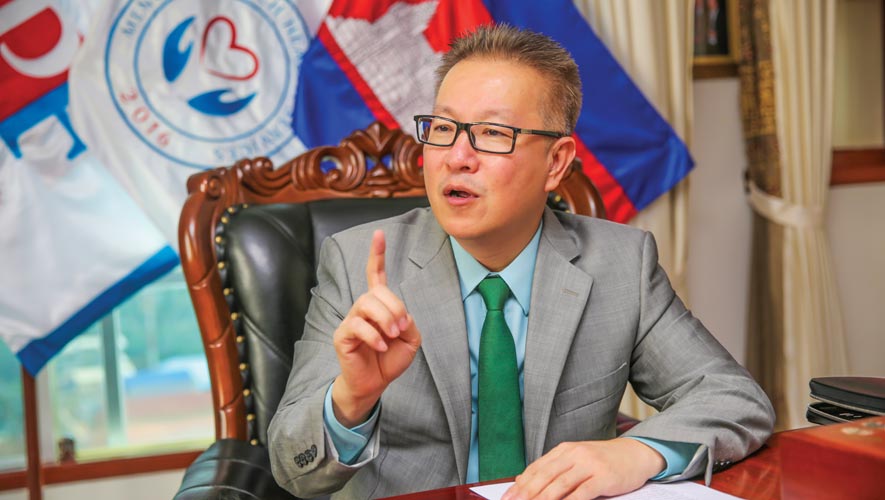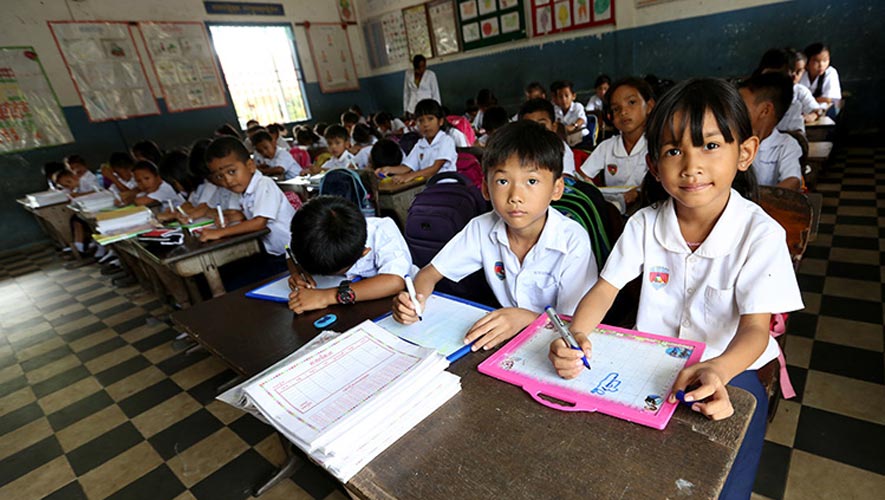It’s plugging the gaps in the public school system, but many call for more regulation
For the latest Cambodian Business news, visit Khmer Times Business
Inequality has long defined the Kingdom’s societal makeup as a wealthy elite rumble through the roads of Phnom Penh in luxury imported cars while the rural majority of the population struggle to survive.
Last month’s country briefing from the Oxford Poverty and Human Development Initiative (OPHDI) revealed that 37.2 percent of Cambodians live in multidimensional poverty.
Naturally, the differences across the country were stark, with 1.5 percent of urban Cambodians living in severe poverty while 15.5 percent lived in rural areas.
Just 8.2 percent of urban dwellers were considered “multidimensionally poor. The OPHDI describes these as deprived in at least one-third of 10 indicators. In rural areas, that number shoots up to 42.8 percent.
Key indicators on the Multidimensional Poverty Index are measured in both years of schooling and school attendance, but an element that goes unrecorded in this methodology is the quality of education. The index also includes nutrition, child mortality, access to fuel, decent housing and assets.
A booming market
As Phnom Penh enters another consecutive year of transformative growth, it’s transition to become a booming metropolis is almost complete – and with such growth has come an explosion in private education institutions, mostly concentrated around the capital.
“You could say that it’s a free market for kindergarten to grade 12 – there’s room to grow, anyone is welcome to come in and take over that chunk of the economy, because it’s booming, it’s open, it’s free,” says Oknha Dr Mengly J Quach, founder of MJQ Education – a private education provider best known for the American Intercon Schools and Aii Language Centres.
Dr Quach notes that it’s not a hugely profitable business – with margins of 0 to 5 percent in his case – because MJQ Education focuses on reinvesting in new facilities, staff training and quality education materials,
“So you can find all kinds of hells and heavens in Cambodia. Often they’re next door to each other,” he says, citing the contrasting literacy rates and school attendance in rural and urban areas. “Right now the gap between rich and poor is getting larger and larger.”
Data provided by the Ministry of Education, Youth & Sports (MOEYS) shows that, for the academic year 2018 to 2019, some 218,357 students were enrolled in 1,222 private schools nationwide, ranging from pre-school to grade 12.

Principal, Australian Centre for Education
Of those 1,222 private schools, 994 were found in urban areas, where 182,846 students were enrolled this previous academic year, leaving just 35,511 students in the 228 private institutions serving rural regions.
Uneven development
Compare these figures to the public school statistics also provided by the MOEYS and a very different picture emerges. For the same academic year, 13,300 schools enrolled 3,189,172 students – also between pre-school and grade 12 – but the split between urban and rural is inversed. Just 1,422 of the nation’s public schools were found in urban areas, compared with 11,878 in rural areas – with the rural schools serving 2,594,258 of the Kingdom’s students.
If the private education sector is booming, it is most certainly happening in areas of urban wealth, but the question of whether it’s replacing the public schools or simply plugging the gaps is up for debate, say observers.
“I’d say it’s risen to the stage where it’s giving people who have the money the opportunity to give their kids more access to potentially better education or, certainly, a wider range,” explains Ashley Irving, principal of the Australian Centre for Education (ACE) – an initiative from global education provider IDP.
“This is a country which is desperate to improve and everyone here is trying to claw their way up and provide the best for their kids, so we’re seeing rapid change. I think we’re seeing levels of education increasing – I think rapidly. I see a discernible improvement,” says Irving, who also serves as the president of the Australian Chamber of Commerce.
He goes on to echo Dr Quach in saying that these improvements are being felt nationwide across both the public and private education systems, while noting that the issue of staffing remains prominent across both systems, but that Minister for Education H E Hang Chuon Naron has done an excellent job in catalysing change.
Generational improvements
“If you think back to the 70s, pretty much all teachers were wiped out, so who are the mentors? There are some terrific public schools producing some terrific students – some of my best teachers come through the state school system – but it’s a generational change,” says Irving.
Despite this, the availability of trained teachers in the Kingdom, coupled with the low salaries in the education sector, are impediments to change. Irving says simply paying teachers more isn’t the solution and that real infrastructural change is needed.
“There are still countryside schools with a need for improvements in basic sanitation and water, so do you put in running water and toilets or do you spend money on developing teachers?”
While both Quach and Irving hint at good, albeit slow progress in the public education system, their enthusiasm wanes when it comes to tertiary education.
Worthless degrees
“I feel sad for the next few generations,” says Quach as he reflects on the Kingdom’s universities, “It seems like we’re not producing intellectuals anymore. We’re just producing these degree mills, paper mills – but no-one dares say it because they don’t want people to look down on the Cambodian system.”
He cites the affordability of university as an indicator of the low standards of education offered in many higher education institutions, where he claims fees range from $500 to $800 per year for tuition and staff receive just $10 to $15 an hour, causing many lecturers to take on extra jobs. This, he says, leaves no time for research, publishing or professional development.
“University has become much more accessible across the world. It’s magnified here because there’s so much demand and there’s an idea that, in some cases, private education will give the kids more advantages than [public] school education,” says Irving. The number of private universities has soared in recent years.
Cambodia’s Education Roadmap 2030, produced by the MOEYS in February this year, notes the development of higher education in the Kingdom.
“From a single university in 1979, the number of higher education institutions in the country increased to eight in 1997, 70 in 2009 and 121 in 2018. With a very low level of participation (only 1 percent of college-aged youths) in the early 1990s, the gross enrolment rate at the tertiary level rose to 6 percent in 2006 and 10 percent in 2018.”
Value for money?
One question that rises from all of these developments is whether the education system is providing the workforce with suitable employees.
According to Gabriel Helmy, chief executive officer and founder of The Capacity Specialists, “We hear many complaints from our clients, in terms of it’s hard to recruit good people – people don’t have the skills that we need – so it’s what is the short term sustainable fix?”
For Helmy, that fix is something The Capacity Specialists are developing, providing tailored work-based training opportunities to employees across a range of sectors, in order to develop soft skills in the workplace such as leadership, teamwork and critical thinking.
“So the skills gap has been in place for a long time. In our view, there are things being done about it, but too slowly for the needs of employers. When we talk with employers, they’re not happy with the quality of the workforce. Of course that drives change and I think that is what has driven fast growth in private schools and in our sector.”

Founder, MJQ Education
He explains that The Capacity Specialists are now moving into recruitment to further address workplace deficiencies, but feels that the skills gap stems from a lack of change in the style of education.
“What’s taught in schools hasn’t really changed over the last 100 years. There’s not a big focus on learning the skills that are needed in the workplace and one of the consequences of the skills gap is that there are more new companies, more new employers that are setting up in Cambodia and they need human resources, but the problem is the pool of quality human resources is smaller.”
As the middle class in Cambodia swells its ranks, the number of students seeking higher education abroad has also risen, according to Chheang Vantak, student placement manager at IDP’s Phnom Penh office.
“Estimated from our market research and intelligence, from one year to another, about 15 to 20 percent growth of a small base of Cambodian self-funded students are going to study overseas,” he says, adding: “The average spend, including the tuition fee and cost of living, would be roughly $35,000 to $37,000 per year. They tend to spend around four years of education overseas for their undergrads or two years for postgrads.”
US-based consultancy firm EY-Parthenon valued Southeast Asia’s private education sector at $60 billion in 2015, as part of a trillion-dollar industry globally. So while the profits of private education appears to have grown, standards and quality have not. This, Irving says, is an issue across the board.
Who’s cashing in?
“Accreditation is important because it gives us a sense of validity and legitimacy to the businesses,” he says, but explains that he’s heard of private schools in Cambodia rebranding as accreditation bodies before accrediting themselves.
“It’s not [officially] recognised, but sounds nice and that’s what we see in a lot of lower level schools.
“They do not offer the same level of validity or compliance, but all the good schools will have some sort of international accreditation.”
As a principal at ACE, Irving says he is unaware of the profit margins, but says he expects them to be “healthy” – in IDP’s annual statement, listed on the Australian Stock Exchange, the group’s Asian operations generated $205.4 million in 2018, up from $160 million in 2017.
Without naming the lower level schools he was referring to, Irving suggests that unscrupulous players could be cashing in on Cambodia’s private education system.
“The private industry is largely unregulated and regulation will come in time, but enforcement is always going to be the challenge – how do you get out to all the private schools and check to see that they’re meeting all the standards by defined perspectives? Standards are incredibly varied, but one thing I’m pretty sure of is if a school is not making a profit, it wouldn’t be running, so they must be happy with the money or they’d be shut down pretty quickly.”




